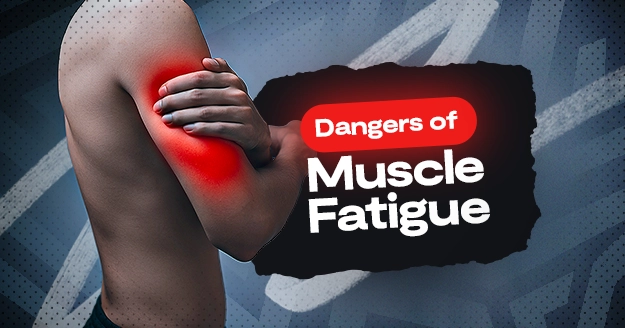Are you regularly experiencing tired muscles after a workout? It’s a common thing among people who exercise. Sometimes, it actually makes you feel accomplished in your exercise routine. However, pushing yourself too hard can lead to muscle fatigue.
What is muscle fatigue?
Muscle fatigue happens when your muscles get tired and can’t work as well. It usually happens after you do a lot of strenuous physical activities. Feeling tired or exhausted is common with muscle fatigue. When fatigue sets in, the strength of your muscle movements decreases, resulting in a sense of weakness. This is usually the first indication.
Muscle fatigue causes soreness, localized pain, breathlessness, muscle twitching, tremors, weakened grip, and muscle cramps.
Causes of Muscle Fatigue
What is muscle fatigue caused by?
Almost everyone has experienced muscle fatigue after working out constantly, but exercise or physical activity isn’t the only cause of muscle fatigue. Other causes of muscle fatigue include the following:
- Addison’s disease
- age
- anaerobic infections
- anemia
- anxiety
- autoimmune diseases, such as myasthenia gravis, Graves’ disease, and Guillain-Barré syndrome
- botulism
- cerebral palsy
- chemotherapy
- chronic fatigue syndrome (CFS)
- dehydration
- depression
- electrolyte imbalances such as hypomagnesemia (magnesium deficiency), hypokalemia (potassium deficiency), and hypercalcemia (elevated calcium in your blood).
- fibromyalgia
- hepatitis C
- herniated disc
- HIV
- hypotonia
- infections such as flu (influenza) and glandular fever (Epstein-Barr virus) and
- Kidney disease
- lack of exercise
- lactic acid production
- medications
- mineral deficiency
- Multiple sclerosis or MS muscle fatigue
- muscular dystrophy
- myositis (muscle inflammation)
- neuralgia
- peripheral neuropathy
- pregnancy
- prolonged bed rest
- sleep deprivation
- stroke
- thyroid conditions, like hypothyroidism and hyperthyroidism
- Tuberculosis
How Long Does Muscle Fatigue Last?
How long you feel muscle fatigue depends on how hard and long you’ve worked your muscles. Normally, after an easy workout, a 24-hour break is enough to recuperate. But if the workout is more intense and very strenuous, you should feel better after 48 to 72 hours of rest, sometimes longer. If it lasts longer, you might have pushed yourself too much, so be mindful for your next workouts.
How to recover from muscle fatigue?
The purpose of recovery is mainly to avoid muscle fatigue – refraining from engaging in any physical activity for a specific period of time. This allows your body the necessary time to rest.
However, there are additional considerations that can contribute to a quicker recovery process. If your muscle fatigue is just caused by physical exhaustion and not because of underlying medical issues, the following tips might help you:
-
Take a Sufficiently Long Break:
Depending on your training intensity and fitness level, it is recommended to take a break of 24 to 72 hours. This period allows your muscles to recover fully and prevents overexertion.
-
Prioritize Adequate Sleep:
Ensure that you get enough sleep to support your body’s recovery process. Quality sleep is needed for your overall well-being and plays a significant role in muscle repair and growth.
Sleep is a super helpful way to recover from tired muscles, and it’s often overlooked. This is really important, especially after doing strength exercises.
Even though you’re sleeping, your body is still active, repairing muscles and regenerating energy. Not getting enough sleep can mess up the repair processes in your muscles and might lead to injuries not healing right. Plus, you might also risk losing muscles.
So, catching those Zs is a key player in keeping your muscles in top shape!
-
Stay Hydrated:
Drinking plenty of fluids is essential for recovery since you lose a lot of it through sweating. Adequate hydration helps flush out toxins, reduces the risk of cramps, and supports overall bodily functions. Make a conscious effort to maintain proper fluid intake.
You can hydrate with plain tap or mineral water. You can also go for isotonic or electrolyte drinks, but be careful with the sugar.
A good drink shouldn’t have more than 8% carbohydrates. Your body might not absorb the liquid fast enough if you go for a drink with more carbs or added sugar. So, keep it balanced for a faster recovery!
-
Nutrient-Rich Post-Workout Meal:
After your workout, eating the right food is key for recovery. During training, your muscles get microinjuries and your glycogen stores get depleted. Also, some of your muscle proteins get broken down and damaged.
Thus, you should consume a meal rich in high-quality proteins and carbohydrates within 45 minutes to 2 hours after your workout.
Including protein-rich foods in your post-workout meal helps your body better absorb the amino acids it needs for rebuilding lost proteins. This not only supports recovery but also sets you up for better performance in your next training session.
Don’t forget about glycogen – your muscles need it replenished for a fresh energy boost, so carbs are crucial, too. While fats aren’t a must-have after exercising, they’re fine in moderation, especially if they’re the healthy, unsaturated kind.
This nutritional combination (protein+carbs) promotes muscle repair and enhances recovery.
Good sources of carbs:
- brown rice
- chocolate milk
- edamame
- fruits
- oatmeal
- potatoes
- quinoa and other grains
- rice cakes
- sweet potatoes
- whole grain bread
- whole grain pasta
Good sources of protein:
- chicken
- cottage cheese
- eggs
- Greek yogurt
- protein bar
- protein powder
- salmon
- Tuna
Good sources of fats:
- avocado
- nut butter
- nuts
- seeds
By leveraging these practices into your routine, you can optimize the recovery phase, allowing your body to bounce back more efficiently after physical exertion.
How to prevent muscle fatigue?
As they say, prevention is better than cure. You can try these methods to prevent muscle fatigue:
- Warm up and cool down. Warm up for 5-10 minutes before exercising to prep your muscles. Post-workout, cool down gradually to bring oxygen back to your muscles for faster recovery.
- Balance training with time for recovery. It’s essential to have at least one full day of rest each week.
- Alternate hard and easy days. Include cross-training and other forms of active rest into your training. For instance, if you focus on your leg muscles today, switch to your arm muscles tomorrow. If today’s workout is intense, go for something lighter tomorrow.
- Proper nutrition. Your food and hydration should be enough to cover what your body needs for physical activities and muscle repair.
- Keep a training log. Keep a log of your well-being (e.g. soreness and heart rate) and exercise levels (e.g. intensity, and duration). Monitoring how you feel daily can help you spot signs of muscle fatigue, allowing you to reduce your load and avoid it.
What happens if you ignore muscle fatigue?
- Develop chronic pain
Ignoring muscle fatigue can escalate into a chronic pain condition. If not treated appropriately, they are well-known for inducing intense pain and spasms.
- Complete rupture
Muscle strain has been associated with muscle fatigue. Neglecting a minor tear by not properly resting and persisting in physical activity is leading a path to a full muscle rupture.
A complete muscle rupture happens when either the tendon is detached from the muscle belly or the muscle belly itself is torn into two parts. This type of strain is usually marked by intense swelling, severe pain, and a complete loss of function in the affected area.
The severity of the tear directly correlates with the time required for recovery, rehabilitation, and return to regular activities.
- Recurring injuries and decreased performance
When you exercise, microscopic tears are created in your muscles. After rest and recovery, cells called fibroblasts repair it.
During the healing process of a torn muscle, two types of tissues form: new muscle fibers and scar tissue.
What happens when you ignore muscle fatigue, meaning not making an effort to recover, is there would be an excess of scar tissue compared to healthy muscle. Consequently, the affected muscle may struggle to regain its usual strength, elasticity, and flexibility.
This permanent damage increases the likelihood of re-injury, and weakened muscles can notably impact your performance during workouts.
- Increased risk of fracture
Healthy muscles act like shock absorbers, protecting your bones from too much stress when you move. But if you’re experiencing muscle aches and fatigue, the stress goes straight to your bones.
This extra stress can lead to painful fractures. If you don’t take care of it, these fractures can become more serious. So, keeping your muscles strong is important to avoid hurting your bones and stay healthy.
- Injuring other soft tissues
When your body tries to make up for fatigued muscles, it puts extra pressure on other muscles, tendons, and ligaments. This can lead to problems like inflammation, pain, and conditions such as tendonitis.









